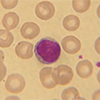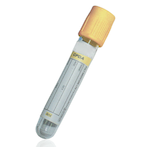
- Home
- Clinical Chemistry Tests
- Phosphate (serum)
Phosphate (serum)
Specimen Volume
2.0 mL blood.Sample Preparation
Centrifuge
Turnaround Time
24 hoursSample Processing In Laboratory
Usual
Sample Stability
4 days at 4 ºC
General Information
Almost all of the phosphorus in the body occurs as phosphate (phosphorus combined with four oxygen atoms), and most of the body's phosphate (85%) is located in the skeletal system, where it combines with calcium to give bones their hardness. The remaining amount (15%) exists in the cells of the body, where it plays an important role in the formation of key nucleic acids, such as DNA, and in the process by which the body turns food into energy (metabolism). The body regulates phosphate levels in the blood through the controlled release of parathyroid hormone (PTH) from the parathyroid gland and calcitonin from the thyroid gland. PTH keeps phosphate levels from becoming too high by stimulating the excretion of phosphate in urine and causing the release of calcium from bones (phosphate blood levels are inversely proportional to calcium blood levels). Calcitonin keeps phosphate blood levels in check by moving phosphates out of the blood and into the bone matrix to form a mineral salt with calcium. Most phosphorus imbalances develop gradually and are the result of other conditions or disorders, such as malnutrition, poor kidney function, or a malfunctioning gland.
Dietary deficiencies in phosphate are rare but may be seen with alcoholism and malnutrition. Low levels of phosphate (hypophosphataemia) may also be due to or associated with:
- Hypercalcaemia (high levels of calcium), especially when due to high levels of parathyriod hormone (PTH)
- Overuse of diuretics (drugs that encourage urination)
- Severe burns
- Diabetic ketoacidosis after treatment
- Hypothyroidism
- Hypokalaemia (low levels of potassium)
- Chronic antacid use
- Rickets and osteomalacia (due to Vitamin D deficiencies)
Higher than normal levels of phosphate (hyperphosphataemia) may be due to or associated with:
- Kidney failure
- Hypoparathyroidism (underactive parathyroid gland)
- Hypocalcaemia (abnormally low levels of calcium)
- Diabetic ketoacidosis when first seen
- Phosphate supplementation
Patient Preparation
None
Notes
Haemolysis interferes with this assay
Reference Range
0.8-1.5 mmol/L
Source of Reference Range
Abbott DiagnosticsSpecifications
- EQA Status: NEQAS
- EQAS Scheme: Yes
Tags
boneRelated Tests
Albumin Calcium (adjusted) Parathyroid Hormone (PTH) Phosphate (Urine) Vitamin D (25-OH VitD)Creation Date
Monday, 08 August 2011Modification Date
Monday, 10 February 2020General Information
Location of Laboratories
Copyright UHB Pathology 2018
Protection of Personal Information – Clinical Laboratory Services comply with the Trust Data Protection Policy and have procedures in place to allow the Directorate and it’s employees to comply with the Data Protection Act 1998 and associated best practice and guidance.
University Hospitals Birmingham medical laboratories at Queen Elizabeth Hospital, Heartlands Hospital, Good Hope Hospital and Solihull Hospital are UKAS (United Kingdom Accreditation Service) accredited to the ISO 15189:2012 standard. For a list of accredited tests and other information please visit the UKAS website using the following link: https://www.ukas.com/find-an-organisation/
- Molecular Pathology is a UKAS accredited medical laboratory No. 8759
- Biochemistry is a UKAS accredited medical laboratory No. 8910
- Haematology and Transfusion is a UKAS accredited medical laboratory No. 8784
- Clinical Microbiology is a UKAS accredited medical laboratory No. 8760
- Cellular Pathology is a UKAS accredited medical laboratory No. 10141
- Musculoskeletal laboratory is a UKAS accredited medical laboratory No. 9897
- Heartlands, Good Hope and Solihull Hospital pathology laboratories are a UKAS accredited medical laboratory No.8217.
Tests not appearing on the UKAS Schedule of Accreditation currently remain outside of our scope of accreditation. However, these tests have been validated to the same high standard as accredited tests and are performed by the same trained and competent staff.
For further test information, please visit the test database: http://qehbpathology.uk/test-database
For further information contact Louise Fallon, Quality Manager, 0121 371 5962
 Biochemistry
Biochemistry Haematology and Transfusion
Haematology and Transfusion Clinical Microbiology (Including Virology)
Clinical Microbiology (Including Virology) Cellular Pathology
Cellular Pathology General Information
General Information Molecular Pathology
Molecular Pathology